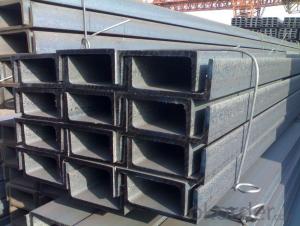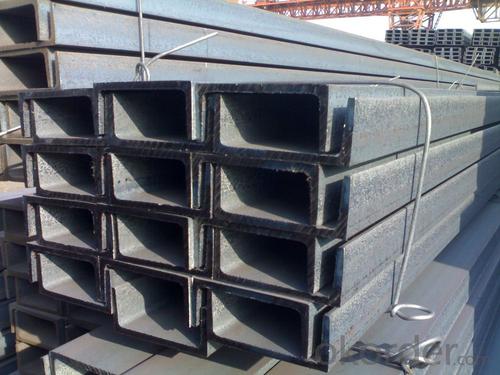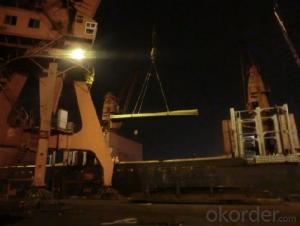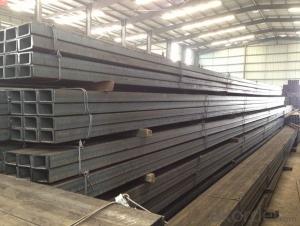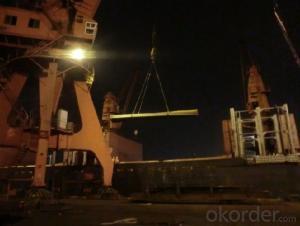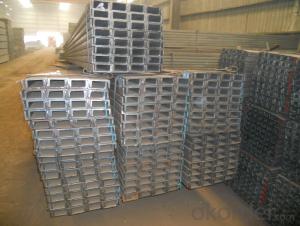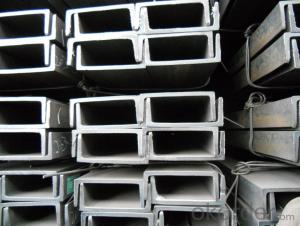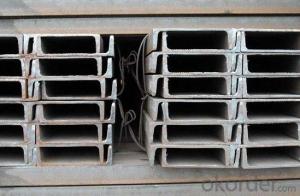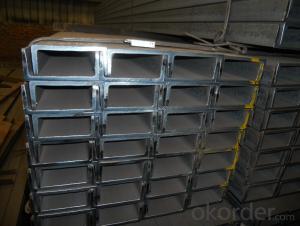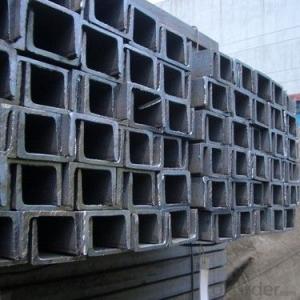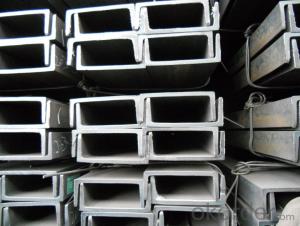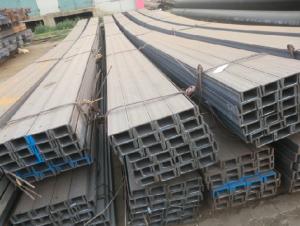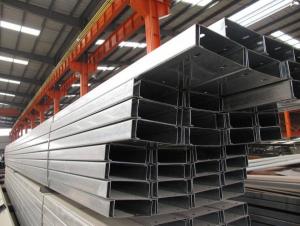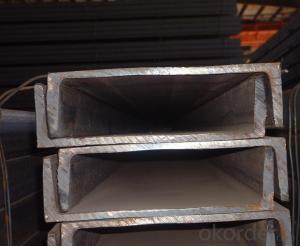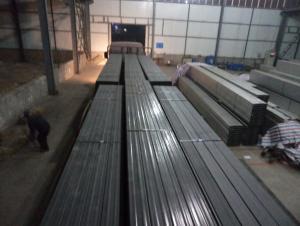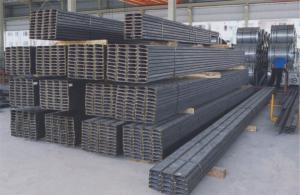High Quality Steel Channel 125mm
- Loading Port:
- China Main Port
- Payment Terms:
- TT OR LC
- Min Order Qty:
- -
- Supply Capability:
- -
OKorder Service Pledge
OKorder Financial Service
You Might Also Like
Steel Channel
Standard: JIS
Material: SS400
Length: 6m, 12m
Size:
| Size (mm) | Mass (Kg/m) |
| 125*65*5.2 | 11.66 |
| 125*65*5.5 | 12.91 |
| 125*65*6.0 | 13.40 |
Package & Delivery of Steel Channel:
1.The hot rolled channel steel will be packed in bundle with steel wire at each end of every bundle and color marking in order to help the customer to recognize his goods more easily at sight.
2. And the hot rolled channel steel could be loaded into 20ft or 40ft container, or by bulk cargo.If the weight of each bundle reaches more than 3.5 mt, the loading by break bulk cargo should be choosed.When the weight of each bundle reaches less than 3mt, the loading by container should be choosed.
3.As for the transportaion from mill to loading port, the truck will be usually used. And the maximum quantity for each truck is 40mt.
4.All in all, we could do in accordance with customer's request.
Production Flow of JIS Channel:
1.The steel billet shall be heated in the high temperature furnace.
2. The heated steel billet shall be rolled five to nine times with the aim of shaping the general figure of steel u channel.
3. The rolled steel channel should be put onto the cooling bed to make the temperature low.
4. The JIS Channel should be straighted on the straightener.
5. The straighted steel u channel will be cut into meters by saw, as per customer's requirements.
6. At the last part of production, the channel steel must be tested in order to confirm that the finished products are completely free from crack, pore, slag, scab or fold on the surface.
*If you would like to get our price, please inform us the size, standard/material and quantity. Thank you very much for your attention.
- Q: How do steel channels compare to other structural materials?
- Steel channels are widely regarded as one of the most versatile and reliable structural materials. They offer exceptional strength-to-weight ratio, making them highly efficient in load-bearing applications. Compared to other materials such as wood or concrete, steel channels are more durable, resistant to corrosion, and have superior fire resistance. Additionally, their uniformity and precision in manufacturing ensure consistent quality and ease of installation. Overall, steel channels outperform many other structural materials due to their exceptional strength, durability, and versatility.
- Q: Can steel channels support electrical wiring?
- Indeed, electrical wiring can be supported by steel channels. In both construction and electrical contexts, steel channels are frequently employed to furnish both structural support and safeguarding for electrical wiring. Typically, they are mounted on walls, ceilings, or floors to mask and shield electrical cables. Steel channels possess great durability, enabling them to bear the weight of electrical wiring and guarantee its security and protection. Furthermore, the installation of steel channels is a straightforward process, offering an orderly and neat means of routing electrical wiring.
- Q: The top of the elevator shaft is not pre buried hook, and now to add channel, in the channel to do hook, elevator Ii Michihiro 2500, asking the hook bearing 3 tons, the need for large channel, detailed explanation
- 2 28 channel steel or 2 25 steel
- Q: How do steel channels contribute to the stability of industrial structures?
- Steel channels contribute to the stability of industrial structures in several ways. Firstly, steel channels provide structural support and reinforcement to the overall framework of a building. They are commonly used as beams or columns to bear heavy loads, distribute weight evenly, and resist bending or buckling. Due to their high strength-to-weight ratio, steel channels can handle significant loads, making them ideal for industrial structures that often require the support of heavy machinery and equipment. Additionally, steel channels enhance the overall stability of industrial structures by offering resistance against lateral forces such as wind or seismic activity. They can be strategically incorporated into the design of a building to create a rigid framework that can withstand these external forces. The shape and cross-sectional properties of steel channels allow for efficient load transfer, reducing the risk of structural failure or collapse during extreme conditions. Furthermore, steel channels are highly durable and resistant to corrosion, which is particularly important in industrial environments. These channels can withstand harsh conditions, such as exposure to chemicals, high temperatures, or moisture, without compromising their structural integrity. By providing long-lasting stability, steel channels ensure the safety and reliability of industrial structures over their lifespan. Lastly, steel channels offer flexibility in design and construction. They can be easily customized to meet specific structural requirements, allowing architects and engineers to optimize the design for maximum stability. Steel channels can be used in various configurations and sizes, enabling the construction of complex and efficient industrial structures. In conclusion, steel channels play a crucial role in enhancing the stability of industrial structures. Their strength, resistance to lateral forces, durability, and flexibility make them an ideal choice for supporting heavy loads and ensuring the overall safety and reliability of industrial buildings.
- Q: What are the different methods for anchoring steel channels to a foundation?
- Different methods exist for anchoring steel channels to a foundation, depending on the specific requirements and load capacity of the structure. Some commonly used methods are as follows: 1. Anchor Bolts: This method involves drilling holes into the foundation and inserting anchor bolts, which are then secured using nuts and washers. This creates a strong connection between the channel and the foundation. 2. Chemical Anchoring: When drilling into the foundation is not feasible or preferred, chemical anchoring can be employed. This method utilizes epoxy resin or adhesive to bond the steel channel to the foundation. The adhesive is applied to the base of the channel and pressed onto the foundation surface. After curing, a strong bond is formed between the channel and the foundation. 3. Welding: Another method for anchoring steel channels involves welding the base of the channel directly to the foundation surface. This method provides a permanent and robust connection; however, it necessitates skilled welders and may not be suitable for all applications. 4. Expansion Anchors: When a temporary or removable connection is required, expansion anchors are utilized. These anchors consist of a bolt or screw inserted into a pre-drilled hole in the foundation. As the bolt is tightened, it expands and wedges itself against the hole's sides, creating a secure connection. 5. Concrete Embedment: In certain cases, steel channels can be directly embedded into the concrete foundation. This method involves pouring concrete around the channel, completely surrounding and encasing the steel. Once the concrete hardens, a solid and permanent connection is established. To select the appropriate anchoring method for steel channels, factors such as load capacity, environmental conditions, and project requirements should be taken into consideration. Consulting a structural engineer or construction professional is advised to ensure the proper selection and installation of the anchoring method.
- Q: How do steel channels contribute to building durability?
- Steel channels contribute to building durability in several ways. Firstly, steel channels provide structural support to the building. They are used to create the framework and framework support for floors, walls, and ceilings. This ensures that the building can withstand heavy loads and remain stable over time. Steel channels have high strength and rigidity, making them resistant to bending, warping, and twisting, which ultimately enhances the overall durability of the structure. Secondly, steel channels are highly resistant to corrosion. They are commonly made from galvanized or stainless steel, both of which have excellent resistance to rust and corrosion. This is particularly important in buildings that are exposed to moisture, such as coastal areas or places with high humidity. By using steel channels, the risk of structural damage caused by rust or corrosion is significantly reduced, leading to increased durability of the building. Furthermore, steel channels offer fire resistance. Steel is inherently non-combustible, meaning it does not contribute to the spread of fire. In the event of a fire, steel channels can help contain the flames and prevent them from spreading to other parts of the building. This fire-resistant property significantly improves the safety and durability of the structure. Lastly, steel channels are highly durable and require minimal maintenance. Unlike other building materials that may deteriorate over time, steel channels have a long lifespan and retain their strength and integrity for many years. They are not susceptible to rot, decay, or insect damage, which can be common issues with wood or other organic materials. This durability and low maintenance requirement make steel channels a cost-effective choice in the long run. In conclusion, steel channels contribute to building durability by providing structural support, corrosion resistance, fire resistance, and low maintenance requirements. Their strength, stability, and longevity make them an ideal choice for creating durable and long-lasting buildings.
- Q: What material does hot-dip galvanized channel belong to?
- Because the hot plating, and basically not stainless steel, I guess it should be carbon steel, which specific material is not clear, the most common is Q235 channel steel.
- Q: Can steel channels be used for equipment supports?
- Yes, steel channels can be used for equipment supports. Steel channels are commonly used in construction and industrial applications for their strength and durability. They can provide stable and reliable support for various types of equipment, such as machinery, heavy tools, and other heavy loads. Steel channels are designed to withstand high loads and can be easily fabricated and installed to suit specific support requirements. Additionally, they can be used in combination with other structural elements, such as beams and columns, to create a robust support system. Overall, steel channels offer a reliable solution for equipment supports due to their strength, versatility, and long-lasting performance.
- Q: What is the weight of steel channels?
- The weight of steel channels can vary depending on the specific dimensions and thickness of the channel. However, as a general guideline, the weight of steel channels can be calculated using the formula: Weight (kg/m) = Width (mm) x Height (mm) x Thickness (mm) x 0.00785 This formula assumes that the steel channel is made of mild steel. Additionally, it is important to note that the weight of steel channels is typically measured in kilograms per meter (kg/m).
- Q: How big is the channel used for the 4 metre span?
- I-beam, also called steel girder, is a long strip steel with cross section.
Send your message to us
High Quality Steel Channel 125mm
- Loading Port:
- China Main Port
- Payment Terms:
- TT OR LC
- Min Order Qty:
- -
- Supply Capability:
- -
OKorder Service Pledge
OKorder Financial Service
Similar products
Hot products
Hot Searches
Related keywords
